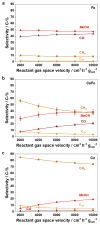Synergistic Effects of Silica-Supported Iron-Cobalt Catalysts for CO2 Reduction to Prebiotic Organics
- PMID: 39363906
- PMCID: PMC7616659
- DOI: 10.1002/cctc.202301218
Synergistic Effects of Silica-Supported Iron-Cobalt Catalysts for CO2 Reduction to Prebiotic Organics
Abstract
To test the ability of geochemical surfaces in serpentinizing hydrothermal systems to catalyze reactions from which metabolism arose, we investigated H2-dependent CO2 reduction toward metabolic intermediates over silica-supported Co-Fe catalysts. Supported catalysts converted CO2 to various products at 180 °C and 2.0 MPa. The liquid product phase included formate, acetate, and ethanol, while the gaseous product phase consisted of CH4, CO, methanol, and C2-C7 linear hydrocarbons. The 1/1 ratio CoFe alloy with the same composition as the natural mineral wairauite yielded the highest concentrations of formate (6.0 mM) and acetate (0.8 mM), which are key intermediates in the acetyl-coenzyme A (acetyl-CoA) pathway of CO2 fixation. While Co-rich catalysts were proficient at hydrogenation, yielding mostly CH4, Fe-rich catalysts favored the formation of CO and methanol. Mechanistic studies indicated intermediate hydrogenation and C-C coupling activities of alloyed CoFe, in contrast to physical mixtures of both metals. Co in the active site of Co-Fe catalysts performed a similar reaction as tetrapyrrole-coordinated Co in the corrinoid iron-sulfur (CoFeS) methyl transferase in the acetyl-CoA pathway. In a temperature range characteristic for deeper regions of serpentinizing systems, oxygenate product formation was favored at lower, more biocompatible temperatures.
Keywords: CO2 Fixation; CoFe Alloy; Heterogeneous catalysis; Hydrothermal Vent; Prebiotic Chemistry.
Conflict of interest statement
Conflict of Interests The authors declare no conflict of interest.
Figures








Similar articles
-
CO2 Fixation to Prebiotic Intermediates over Heterogeneous Catalysts.Acc Chem Res. 2024 Aug 6;57(15):2038-2047. doi: 10.1021/acs.accounts.4c00151. Epub 2024 Jul 18. Acc Chem Res. 2024. PMID: 39024180 Free PMC article.
-
Effects of Silica Modification (Mg, Al, Ca, Ti, and Zr) on Supported Cobalt Catalysts for H2-Dependent CO2 Reduction to Metabolic Intermediates.J Am Chem Soc. 2022 Nov 23;144(46):21232-21243. doi: 10.1021/jacs.2c08845. Epub 2022 Nov 9. J Am Chem Soc. 2022. PMID: 36350298 Free PMC article.
-
Chemical Antiquity in Metabolism.Acc Chem Res. 2024 Aug 20;57(16):2267-2278. doi: 10.1021/acs.accounts.4c00226. Epub 2024 Jul 31. Acc Chem Res. 2024. PMID: 39083571 Free PMC article.
-
Older Than Genes: The Acetyl CoA Pathway and Origins.Front Microbiol. 2020 Jun 4;11:817. doi: 10.3389/fmicb.2020.00817. eCollection 2020. Front Microbiol. 2020. PMID: 32655499 Free PMC article. Review.
-
Life with CO or CO2 and H2 as a source of carbon and energy.FASEB J. 1991 Feb;5(2):156-63. doi: 10.1096/fasebj.5.2.1900793. FASEB J. 1991. PMID: 1900793 Review.
Cited by
-
GTP before ATP: The energy currency at the origin of genes.Biochim Biophys Acta Bioenerg. 2025 Jan 1;1866(1):149514. doi: 10.1016/j.bbabio.2024.149514. Epub 2024 Sep 24. Biochim Biophys Acta Bioenerg. 2025. PMID: 39326542 Free PMC article. Review.
-
Evidence for corrin biosynthesis in the last universal common ancestor.FEBS J. 2025 Feb;292(4):827-850. doi: 10.1111/febs.17367. Epub 2024 Dec 21. FEBS J. 2025. PMID: 39708285 Free PMC article.
References
-
- Oparin AI. The origin of life. The MacMillan Company; New York City: 1938. p. 127.
-
- Haldane JBS. Rationalist Annual. 1929;148:3–10.
-
- Chyba C. Nature. 1992;355:125–132. - PubMed
Grants and funding
LinkOut - more resources
Full Text Sources
